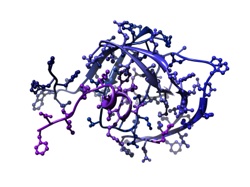A magazine where the digital world meets the real world.
On the web
- Home
- Browse by date
- Browse by topic
- Enter the maze
- Follow our blog
- Follow us on Twitter
- Resources for teachers
- Subscribe
In print
What is cs4fn?
- About us
- Contact us
- Partners
- Privacy and cookies
- Copyright and contributions
- Links to other fun sites
- Complete our questionnaire, give us feedback
Search:
The cure that just folds away

Biologists want you to play games in the name of science. A group of researchers at the University of Washington have invented a computer game, Foldit, in which you have to pack what looks like a 3D nest of noodles and elastics into the smallest possible space. You drag, turn and squeeze the noodles until they’re packed in tight. You compete against others, and as you get better you can rise through the ranks of competitors around the world. How can that help science? It’s because the big 3D jumbles represent models of proteins, and figuring out how proteins fold themselves up is one of the biggest problems in biology. Knowing more about how they do it could help researchers design cures for some of the world’s deadliest diseases.
The perfect fit
Proteins are in every cell in your body. They help you digest your food, send signals through your brain, and fight infection. They’re made of small molecules called amino acids. It’s easy for scientists to figure out what amino acids go together to make up a protein, but it’s incredibly difficult to figure out the shape they make when they do it. That’s a shame, because the shape of a protein is what makes it able to do its job. Proteins act by binding on to other molecules – for example, a protein called haemoglobin carries oxygen around our blood. The shape of the haemoglobin molecule has to fit the shape of the oxygen molecule like a lock and key. The close tie between form and function means that if you could figure out the shape that a particular protein folds into, you would know a lot about the jobs it can do.

Completely complex
Protein folding is part of a group of problems that are an old nemesis of computer scientists. It’s what’s known as an NP-complete problem. That’s a mathematical term that means it appears there’s no shortcut to calculating the answer to a problem. You just have to try every different possible answer before you arrive at the right one. There are other problems like this, like the Tantrix rotation puzzle. Because a computer would have to check through every possible answer, the more complex the problem is the longer it will take. Protein folding is particularly complex – an average-sized protein contains about 100 amino acids, which means it would take a computer a billion billion billion years to figure out. So a shortcut would be nice then.
Puzzling out a cure
Obviously the proteins themselves have found a shortcut. They fold up all the time without having to have computers figure it out for them. In order to get to the bottom of how they do it, though, scientists are hoping that human beings might provide a shortcut. Humans love puzzles, and we’re awfully good at visual ones. Our good visual sense means we see patterns everywhere, and we can easily develop a ‘feel’ for how to use those patterns to solve problems. We use that sense when we play games like chess or Go. The scientists behind Foldit reckon that if it turns out that humans really are more efficient at solving protein folding problems, we can teach some of our tricks to computers.
If there were an efficient way to work out protein structure, it could be a huge boon to medicine. Diseases depend on proteins too, and lots of drugs work by targeting the business end of those proteins. HIV uses two proteins to infect people and replicate itself, so drugs disrupt the workings of those proteins. Cancer, on the other hand, damages helpful proteins. If scientists understood how proteins fold, they could design new proteins to counteract the effects of disease. So getting to the top of the tables in Foldit could hold even more glory for you than you bargained for – if your protein folding efforts help cure a dreaded disease, hey, maybe it’s the Nobel Prize you’ll end up winning.


